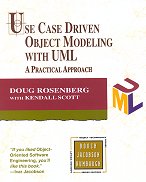
The Unified Process Explained is a concise, accessible, and practical guide that’s meant to help significantly shorten the learning curve for practitioners unfamiliar with this methodology. It explains the essentials of the Unified Process (the RUP’s 5 core elements), guides you through the process step-by-step, and shows how you can put the methodology to work on your next project.
The book starts with a useful overview of the history, motivation, key concepts, and terminology of the Unified Process. The author then details the five pillars of development: requirements, analysis, design, implementation, and test workflows. In addition, the book enumerates the four phases of Unified Process development: inception, elaboration, construction, and transition; and it shows how the workflows are integrated into these phases. In laying out the details of this integration, the book illustrates the Unified Process’s most useful feature – its iterative nature.
With this book as your guide, you will gain an understanding of important concepts and activities such as:
• Iterations and increments
• Business and domain modeling
• Identifying actors and use cases
• Prototyping the user interface
• Robustness analysis
• Design and deployment models
• Statechart and activity diagrams
• Implementation models
A large-scale example of an Internet bookstore runs throughout the book to illustrate concepts and techniques. The industry-standard Unified Modeling Language is used to express structure and function. The Unified Process Explained demystifies this valuable methodology and will lead you on your way to successfully applying the Rational Unified Process.
Written for those with a basic understanding of object-oriented analysis and design, this book begins with a summary of UML’s history, development, and rationale; it then moves into a discussion of how the UML can be integrated into the object-oriented development process. The primary author profiles the various modeling techniques in the UML—such as use cases, class diagrams, and interaction diagrams—and describes the notation and semantics clearly and succinctly. He also outlines useful non-UML techniques such as CRC cards and patterns. These descriptions are made even more relevant with a collection of best practices based on the primary author’s experience and a brief Java programming example demonstrating the implementation of a UML-based design. With this tour of the key parts of the UML, readers will be left with a firm foundation upon which to build models and develop further knowledge of the Unified Modeling Language.
What a super little book. This could easily be called “UML in 2 hours” – which is about how long it takes to read. But this is not just a whistle-stop tour of the notation. Fowler give solid pragmatic advice, in his usual lucid readable style, how and when to use each piece of the notation in analysis and design – and, just as importantly, when not to use it. There’s more good solid advice and guidance in here than in many of the larger doorstop-thick tomes.